Article by Master Chef Irfan khan
President and Secretary General
WAMC India

India is known for Its culture, Tradition, Heritage, Rivers, lakes, Pilgrims, Architecture, Festivals, and food that has been developing for thousands of years and varies from region to region. Here is a brief overview of the Culture, Tradition, and Food of India.
India is known for Its warm Hospitality. Our hospitality Tag line is ‘Atithi Devo Bhava’, it is a Sanskrit verse from Hindu scriptures that translates as ‘the guest is equivalent to god’. In Indian culture, guests are always treated like God. In the current decade, it is part of empowering tourism in the country. and “NAMASTE ” is our Greeting. It is one of the most popular customs and traditions in Indian culture sometimes it is called namaskar or namaskaram, which means ‘I bow to the divinity in you’. This respectful way of saying hello, goodbye, and thank you! has been seen around the world during the Coronavirus outbreak as an alternative to handshakes and hugs. The Namaste Gesture is performed by placing both hands palms together in front of the chest, fingers pointing upwards, and making a slight bow.
Being the world’s second most populous nation (after China), India has an extensive range of languages. The constitution recognizes many regional languages but Hindi and English are recognized as the official languages.
Our Indian Culture is full of unique customs and traditions that should be explored. These cultural aspects differ widely across India, and many of them stem from ancient Indian scriptures and texts, which leads the way of life in India for centuries.
The favorite custom and tradition in Indian culture is food! India has Diversity in Region, Religion, and tradition. Every region has its own distinct cuisine with a signature dish or ingredient.
Next most favorite custom and tradition in Indian culture is festivals. There are hundreds of celebrations to experience in India, which means every day holds a new celebration. The variety of festivals represents India’s rich culture and traditions, with state-wide, religion-based, and community-focused festivals on offer. Hindu Community celebrates Diwali, Holi, Makar Sakranti, Ganesh
Hindu Community celebrates Diwali, Holi, Makar Sakranti, Ganesh
Chaturthi, and many more. Whereas Muslim Communities observe Ramadan ,Eid etc Baisakhi (crop harvesting) is celebrated by the Sikh community, Jains commemorate Mahavir Jayanti and Buddhists mark Buddha’s birthday. Christmas and Good Friday are celebrated by Christians too. Then there are festivals to honor saints, public figures, and gurus.
After this let’s talk about our eating Customs or Culture. As an Indian, I strongly believe that a family which eats together stays together. Our mealtime is a strong source of family bonding, talking, and sharing. An Indian meal is always meant to be shared. Indians believe That “sitting down” with their family for a meal is one of the most important activities of the day for us which makes our bond strong.
Like the western cultures, there are also three main meals in the Indian culture. In India, most people eat a morning meal, a mid-day meal, and an evening meal. Eating with your hands is also very hygienic
 Eating with our Fingers (without Cutlery)is part of the Indian culture. It is believed That There are several health benefits from eating with your hands such as:-
Eating with our Fingers (without Cutlery)is part of the Indian culture. It is believed That There are several health benefits from eating with your hands such as:-
It Improves digestion and prevents diabetes.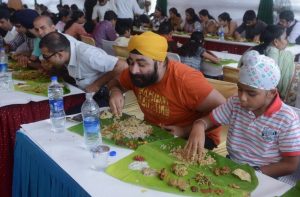
The etiquette and Customs of Indian dining and socializing vary with the region in India. When we eat we Indian wash our hands thoroughly prior and after to dining. eating with our hands, specifically our fingers it is originated from the Ayurveda, where it is believed that our bodies are in sync with the five elements of nature and each finger is an extension of one of these five elements as follows:-
• Through the thumb comes space
• Through the forefinger comes air
• Through the mid-finger comes fire
• Through the ring finger comes water
• Through the pinky finger comes earth
In a traditional way Indian sit on the floor to eat with their family and loved ones. They keep their food on a piece of cloth or serving mat which is known as “Dastarkhan” in Muslim Communities. In Hinduism, they use Thali, Chhoki, Sal leaf plates, and bowl, known as Pattal and Dona for keeping the food. Whereas in another part of India banana leaf ” vazha ilai” is widely used. The size of the leaf may vary from Community to Community.
India consists of a variety of regional and traditional cuisines native to India. Indian cuisine has diversity in soil, climate, culture, Tradition, and occupations. The Staple foods of India are pearl millet, rice, whole-wheat flour, and a variety of lentils.
Indian food is also heavily influenced by religion, in particular Hinduism and Islam, cultural choices, and traditions. Historical events such as invasions, trade relations, and colonialism have played a vital role in introducing certain foods to India.
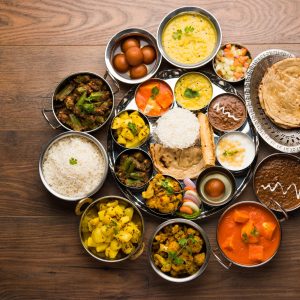 Traditional foods of India are often based on a holistic approach to nutrition, as required by local people. Such foods are prepared with locally available ingredients and found to have its own therapeutic and nutritional benefits. Religion and Food are also connected which adds meaning and significance to our lives. Some food beliefs and practices are based on religion.
Traditional foods of India are often based on a holistic approach to nutrition, as required by local people. Such foods are prepared with locally available ingredients and found to have its own therapeutic and nutritional benefits. Religion and Food are also connected which adds meaning and significance to our lives. Some food beliefs and practices are based on religion.
Each region has its own religions, culture, and traditions that influence its food. Most of the Hindu Communities tend to be vegetarian and Muslim communities tend to have meat dishes, although pork is forbidden. Indian food has been influenced by international Cuisines like Mongolian, Persian, and Chinese middle eastern cuisine, among others. The common thread throughout the centuries remains the distinct mixing of spices that invariably give Indian cuisine its flavor and aroma.
In Indian Cuisine, lots of Spices are used. India is the largest producer, consumer, and supplier of spices.
Hence India is considered ‘The Land of Spices’.
 Indian Spices are world-famous for their flavor, fine texture, and Aroma. every single spice used in Indian dishes carries some or other nutritional as well as medicinal properties.
Indian Spices are world-famous for their flavor, fine texture, and Aroma. every single spice used in Indian dishes carries some or other nutritional as well as medicinal properties.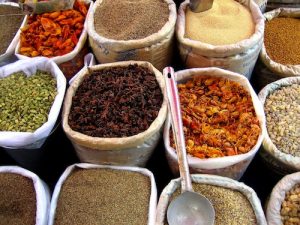 Indian food is different from the rest of the world not only in taste but also in cooking methods. It reflects a perfect blend of various cultures and Traditions.
Indian food is different from the rest of the world not only in taste but also in cooking methods. It reflects a perfect blend of various cultures and Traditions.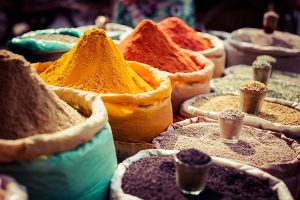 its fish and coconut milk-dominant cuisine. Gujarati cuisine is mostly vegetarian and has an underlying sweetness to many of its dishes due to Chinese influence. Since the dry climate of this region produces smaller vegetables, this region is well known for its chutneys, which are popular Indian condiments that use cooked, fresh, or pickled vegetables and fruits with sweet, sour, or spicy flavors. Goa acted as a major trade port and colony for Portugal, resulting in a distinctive and unique blend of Indian and Portuguese culinary elements. Goan cuisine uses pork and beef with greater frequency than other regional cuisines in India. Vinegar is also a characteristic ingredient of Goan cuisine, another result of Portuguese influence. The prevalence of coconut milk, coconut paste, and fish in Goan cuisine results from its coastal location. Vindaloo is a traditional Goan dish that is an Indian restaurant mainstay, its name deriving from Vinho de Alho, a Portuguese marinade consisting primarily of garlic, wine, vinegar, and chilies.
its fish and coconut milk-dominant cuisine. Gujarati cuisine is mostly vegetarian and has an underlying sweetness to many of its dishes due to Chinese influence. Since the dry climate of this region produces smaller vegetables, this region is well known for its chutneys, which are popular Indian condiments that use cooked, fresh, or pickled vegetables and fruits with sweet, sour, or spicy flavors. Goa acted as a major trade port and colony for Portugal, resulting in a distinctive and unique blend of Indian and Portuguese culinary elements. Goan cuisine uses pork and beef with greater frequency than other regional cuisines in India. Vinegar is also a characteristic ingredient of Goan cuisine, another result of Portuguese influence. The prevalence of coconut milk, coconut paste, and fish in Goan cuisine results from its coastal location. Vindaloo is a traditional Goan dish that is an Indian restaurant mainstay, its name deriving from Vinho de Alho, a Portuguese marinade consisting primarily of garlic, wine, vinegar, and chilies. Let’s talk about Eastern Indian cuisine. it is primarily known for its desserts. These desserts are not only favored by other regions in India but are frequently found at Indian restaurants, their light sweetness making an excellent finale to a meal. Rasgulla is a popular sweet treat consisting of semolina and cheese curd (chenna) balls that are boiled in a light sugar syrup. Eastern dishes favor mustard seeds, poppy seeds, and mustard oil, giving dishes a light pungency. Rice and fish also feature prominently in Eastern cuisine. Overall, Eastern dishes are more lightly spiced than those from other regions of India.
Let’s talk about Eastern Indian cuisine. it is primarily known for its desserts. These desserts are not only favored by other regions in India but are frequently found at Indian restaurants, their light sweetness making an excellent finale to a meal. Rasgulla is a popular sweet treat consisting of semolina and cheese curd (chenna) balls that are boiled in a light sugar syrup. Eastern dishes favor mustard seeds, poppy seeds, and mustard oil, giving dishes a light pungency. Rice and fish also feature prominently in Eastern cuisine. Overall, Eastern dishes are more lightly spiced than those from other regions of India.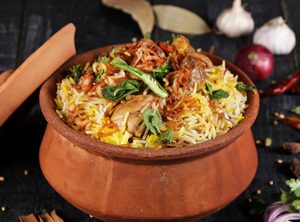 On the other hand, Southern Indian cuisine is not typically found on many Indian restaurant menus and differs greatly from other regions. Its “curries” contrast differently in their textures and can typically be categorized according to the drier consistency, or those favoring a more soupy or stew-like presentation. Poriyals, dry curries consisting of a variety of vegetables and spices, accompany rice dishes. Sambars, rasams, and kootus, three common stew-like dishes, each differs in their primary ingredients and degrees of liquidity. Sambars are essentially tamarind-flavored pea and vegetable stews that are more watery than curries from other regions but are thicker than rasams. Rasams are more similar to soups in their consistency and are composed primarily of tomato, tamarind, and a myriad of spices.
On the other hand, Southern Indian cuisine is not typically found on many Indian restaurant menus and differs greatly from other regions. Its “curries” contrast differently in their textures and can typically be categorized according to the drier consistency, or those favoring a more soupy or stew-like presentation. Poriyals, dry curries consisting of a variety of vegetables and spices, accompany rice dishes. Sambars, rasams, and kootus, three common stew-like dishes, each differs in their primary ingredients and degrees of liquidity. Sambars are essentially tamarind-flavored pea and vegetable stews that are more watery than curries from other regions but are thicker than rasams. Rasams are more similar to soups in their consistency and are composed primarily of tomato, tamarind, and a myriad of spices.
 One of the staples of Filipino cuisine is rice, which is often served with a variety of dishes. Adobo is one such dish, which features meat (usually pork or chicken) marinated in a mix of soy sauce, vinegar, garlic, and other spices before being stewed. The result is a flavorful and tender dish that is a beloved favorite among Filipinos.
One of the staples of Filipino cuisine is rice, which is often served with a variety of dishes. Adobo is one such dish, which features meat (usually pork or chicken) marinated in a mix of soy sauce, vinegar, garlic, and other spices before being stewed. The result is a flavorful and tender dish that is a beloved favorite among Filipinos. with evaporated milk and ice cream. Another sweet favorite is bibingka, a rice cake that is often served during the Christmas season and is typically topped with butter, cheese, and salted egg.
with evaporated milk and ice cream. Another sweet favorite is bibingka, a rice cake that is often served during the Christmas season and is typically topped with butter, cheese, and salted egg.


 Unfortunately, with
Unfortunately, with 




